Plastic Shell Type Circuit Breaker M1 Series
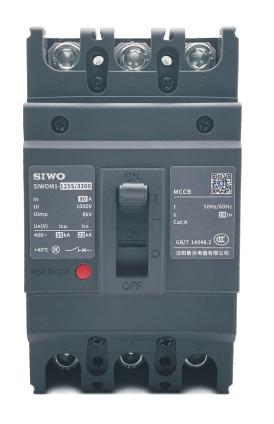
Plastic Case Circuit Breaker: ZSEE M1 series utilizes a thermal-magnetic trip unit. This product offers a beautiful appearance, compact structure, long service life, low rated power consumption, stable performance, and convenient installation, providing users with safe and reliable protection.
This circuit breaker has an isolation function.
It features ON and OFF position indicators. When the contacts are open, the handle indicates the ON and OFF positions: the handle’s position, whether rotated or operated, remains consistent with the body and does not affect the product’s reliability.
The circuit breaker does not support reverse connection and should be connected with power lines to poles 1, 3, and 5, and load lines to poles 2, 4, and 6.
The circuit breaker can be installed vertically (upright) or horizontally (flat).
It has a current-limiting capability. The entire series is designed with a current-limiting mechanism, which extinguishes the arc before the expected short-circuit current reaches its peak, effectively suppressing the impact of short-circuit current on the circuit. The diagram illustrates the actual short-circuit current peak interrupted by the current-limiting mechanism compared to the expected short-circuit current peak curve.
Compliance Standards
GB/T 14048.1 “Low-voltage Switchgear and Controlgear—Part 1: General Rules” (IEC60947-1:2011, MOD)
GB/T 14048.2 “Low-voltage Switchgear and Controlgear—Part 2: Circuit Breakers” (IEC60947-2:2006, IDT)
Environmental Conditions and Applications
- Ambient air temperature: -5℃ to +40℃;
- Altitude of the installation location should not exceed 2000m;
- The relative humidity at the installation site should not exceed 50% at a maximum temperature of +40℃. Higher relative humidity is allowed at lower temperatures, for example, up to 90% at 20℃. Special measures should be taken to handle condensation due to temperature changes;
- Pollution degree: 3;
- Installation type for the main circuit: III; for other auxiliary and control circuits: II;
- The circuit breaker is suitable for electromagnetic environment A;
- Tropical humid type (TH type) circuit breaker complies with GB/T 2423.4 and GB/T 2423.18 requirements, resistant to humid air, salt spray, oil mist, and mold;
- The circuit breaker should be installed in places without explosive hazards, conductive dust, or corrosive elements that can damage insulation and metal parts;
- The circuit breaker should be installed in locations free from rain or snow;
- Storage conditions: ambient air temperature -25℃ to +70℃. Note: The circuit breaker complies with GB/T 2423.1 and GB/T 2423.2 requirements. For de-rating factors, refer to the temperature and altitude de-rating factor table.
Main Features of the ZSEEM1 Series Circuit Breaker
- The circuit breaker provides various protection functions (overload, short-circuit, undervoltage protection), adjustable action values, high breaking capacity, convenient operation, and safety, making it widely used;
- The circuit breaker can be used to switch load circuits and control infrequent motor starts. Its function is equivalent to the combination of a disconnector, overcurrent relay, undervoltage relay, thermal relay, and residual current device, making it an essential protective device in low-voltage distribution networks;
- The internal structure of the circuit breaker is precise, yet the principle is simple. An inductor is connected between the input and output, and when the current exceeds the rated value, the coil drives the core to perform protective actions;
- The main contacts of the circuit breaker can be manually or electrically operated. After closing the main contacts, the free trip mechanism locks the main contacts in the closed position. The overcurrent trip unit’s coil and the thermal element of the thermal trip unit are connected in series with the main circuit, while the undervoltage trip unit’s coil is connected in parallel with the power supply. When a short circuit or severe overload occurs, the armature of the overcurrent trip unit attracts, causing the free trip mechanism to act, and the main contacts open the main circuit. When an overload occurs, the thermal element of the thermal trip unit heats up, causing the bimetal to bend and trigger the free trip mechanism. When undervoltage occurs, the armature of the undervoltage trip unit releases, activating the free trip mechanism. The shunt trip unit is used for remote control and is de-energized during normal operation. For remote control, pressing the shunt button energizes the coil, and the armature drives the free trip mechanism, opening the main contacts;
- The design of the circuit breaker’s moving, static contacts, and contact arms in parallel leverages the electromagnetic repulsion force generated by short-circuit currents to separate the moving and static contacts, providing high breaking capacity and strong current-limiting characteristics;
- The arc extinguishing chamber of the circuit breaker uses a metal grid structure, and the contact system has a repulsion current-limiting mechanism, ensuring high breaking and current-limiting capabilities;
- The circuit breaker features a combined trip unit. The inverse time delay is triggered by the bending of the bimetal under heat, while the instantaneous action is driven by the armature and core mechanism. Trip modes include electromagnetic and combined trip units;
- The modular design of the circuit breaker accessories ensures easy installation and reliable protection;
- The circuit breaker has an overload alarm without trip function. In the event of an overload alarm, the circuit breaker does not trip, and the main circuit remains closed, ensuring power supply safety.
Application Scope of the ZSEEM1 Series Circuit Breaker
The ZSEEM1 series plastic case circuit breaker has a rated insulation voltage of 1000V and is suitable for AC frequency of 50/60Hz, with a rated operating voltage of 690V and below, and rated operating current up to 800A for infrequent operation and motor starting (Inm ≤ 630A and below).
The circuit breaker has overload, short-circuit, and undervoltage protection functions, safeguarding lines and power equipment from damage.
Based on its rated ultimate short-circuit breaking capacity, the circuit breaker is classified into four types: C type (basic), L type (standard), M type (higher breaking), and H type (high breaking).
The circuit breaker features a small size, high breaking capacity, short arc, vibration resistance, modular accessory installation, and easy use.
Rated ultimate short-circuit breaking capacity of 36-50kA is mainly applicable to residential buildings, large shopping malls, hospitals, schools, public buildings, and industrial plants.
Rated ultimate short-circuit breaking capacity of 70-100kA is mainly applicable to power-grade power equipment.
ZSEEM1 Series Circuit Breaker Model Description
ZSEEM1 Series Circuit Breaker Quick Selection Table
ZSEEM1 Series Circuit Breaker Trip Unit Type and Internal Accessory Codes
Main Technical Performance Indicators of the ZSEEM1 Series Circuit Breaker
ZSEEM1 Series Circuit Breaker Characteristic Curves
ZSEEM1 Series Circuit Breaker Application Type: Distribution Type
The distribution type ZSEEM1 series circuit breaker can be divided into two trip unit types:
① Thermal-magnetic trip unit with code 3. Example model: ZSEEM1-125M/3300
ZSEEM1 Series Circuit Breaker Application Type: Motor Protection Type
The motor protection type ZSEEM1 series circuit breaker can be divided into two trip unit types:
① Thermal-magnetic trip unit with code 3. Example model: ZSEEM1-125M/33002
ZSEEM1 Series Circuit Breaker Temperature Derating Coefficients
Current-temperature characteristics for thermal-magnetic circuit breakers when ambient temperature exceeds +40℃.
ZSEEM1 Series Circuit Breaker High Altitude Derating
When the altitude exceeds the operating environment’s 2000m, the electrical performance of the circuit breaker is corrected according to the table below:
ZSEEM1 Series Circuit Breaker Dimensions and Installation Dimensions
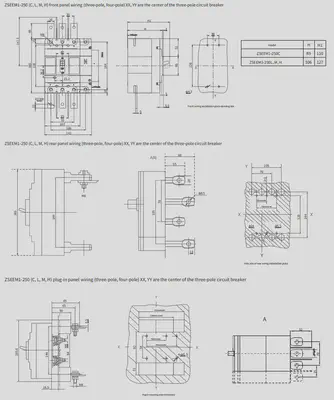
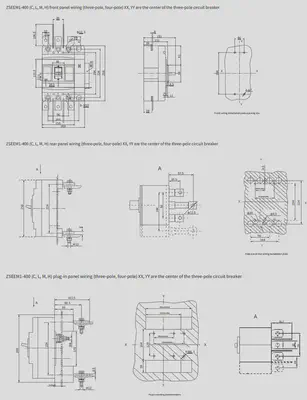
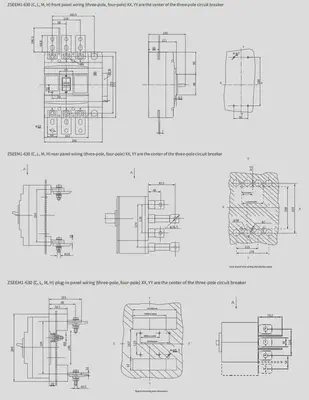
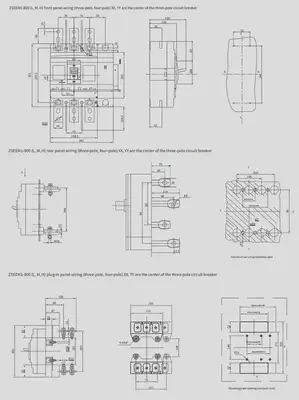
Internal and External Accessories of ZSEEM1 Series Circuit Breakers
1. Shunt Release Series
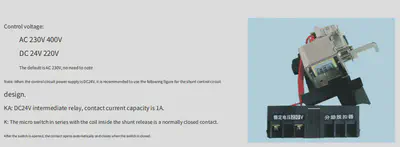
2. Undervoltage Release Series
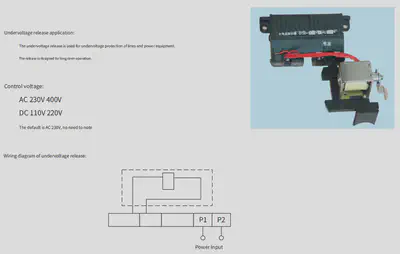
3. Auxiliary Contact Series
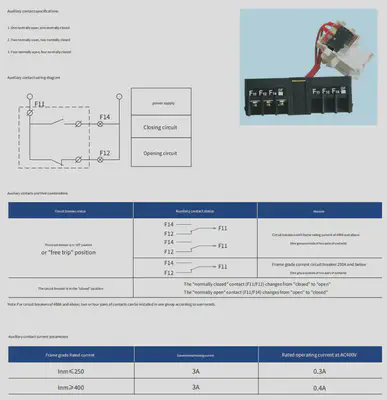
4. Alarm Contact Series
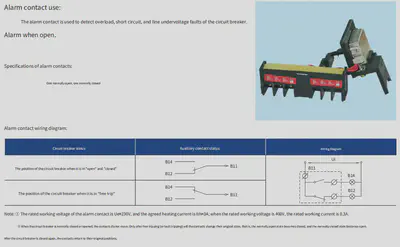
5. Electric Operating Mechanism
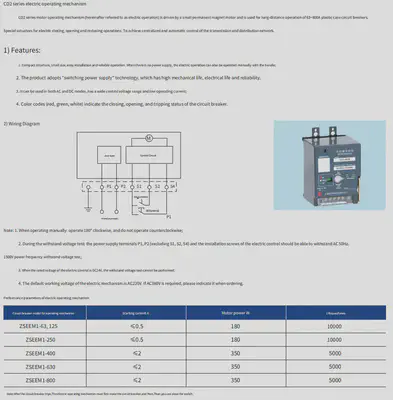
6. Overload Alarm Without Tripping

7. Interlock Mechanism and Related Dimensions
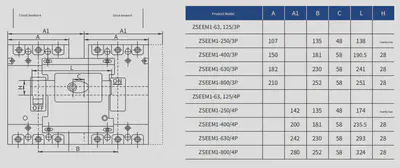
8. Manual Operating Mechanism Series
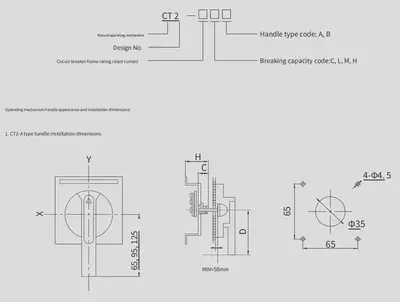
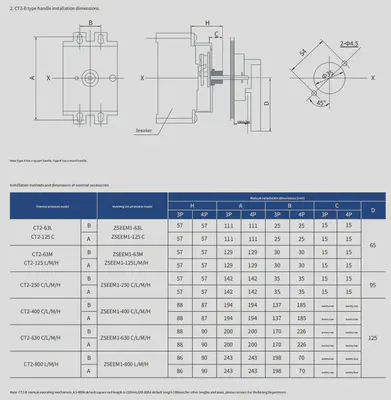
9. Installation Safety Clearance of ZSEEM1 Series Circuit Breakers
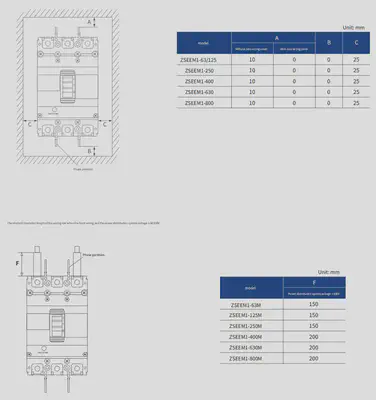
- Due to continuous upgrades and optimizations in our product technology, all information contained in this document is subject to the actual product. Changes may be made without prior notice. Our company and its employees are not responsible for any disputes arising from information in this document that has not been confirmed by our business department.